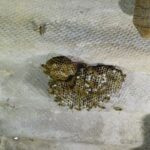How Do Wasps Communicate?
Unlike other insects, wasps communicate by using pheromones. This chemical smell is not detected by humans, but it’s used for communication and to mark objects. It also communicates the location of a food source or a mate. It can also warn other wasps of danger.
Pheromones are chemical smells that wasps emit from their wings or stingers. They are odorless to humans, but other wasps can detect them. Pheromones are important to the mating process, and different species blend the pheromones to attract the right mate. In addition to using pheromones to communicate, wasps use pheromones to mark their territory and attract other wasps.
The antennae of wasps are made up of a stout base attached to the head and eleven short joints. The antennae can rotate in many directions for touch and smell. They are also equipped with hairs, which give the wasps the ability to detect pressure differences in the air. The hairs are called the Johnston’s organ.
Some wasps use a wing beat to signal danger. The wing beat is a signal that stimulates other wasps to defend the nest. It can range from 117 to 247 beats per second.
Adult wasps also perform LV, which involves the entire body. The rhythm and pattern of the drumming sound is indicative of the food source. They also communicate with other wasps by leaving trails for them.
Wasps also communicate using their sense of taste. They are capable of distinguishing between chemical signals and the smell of food.








